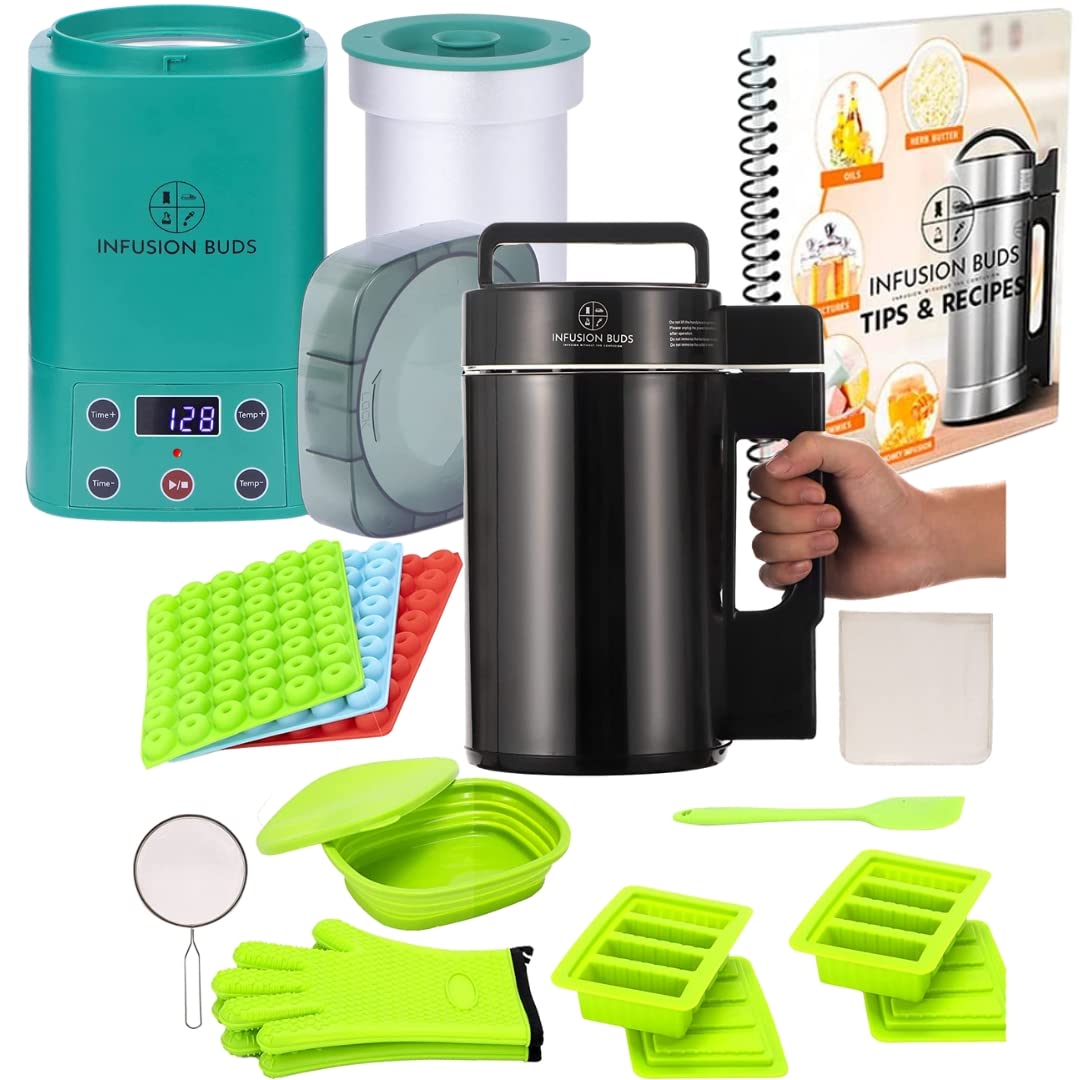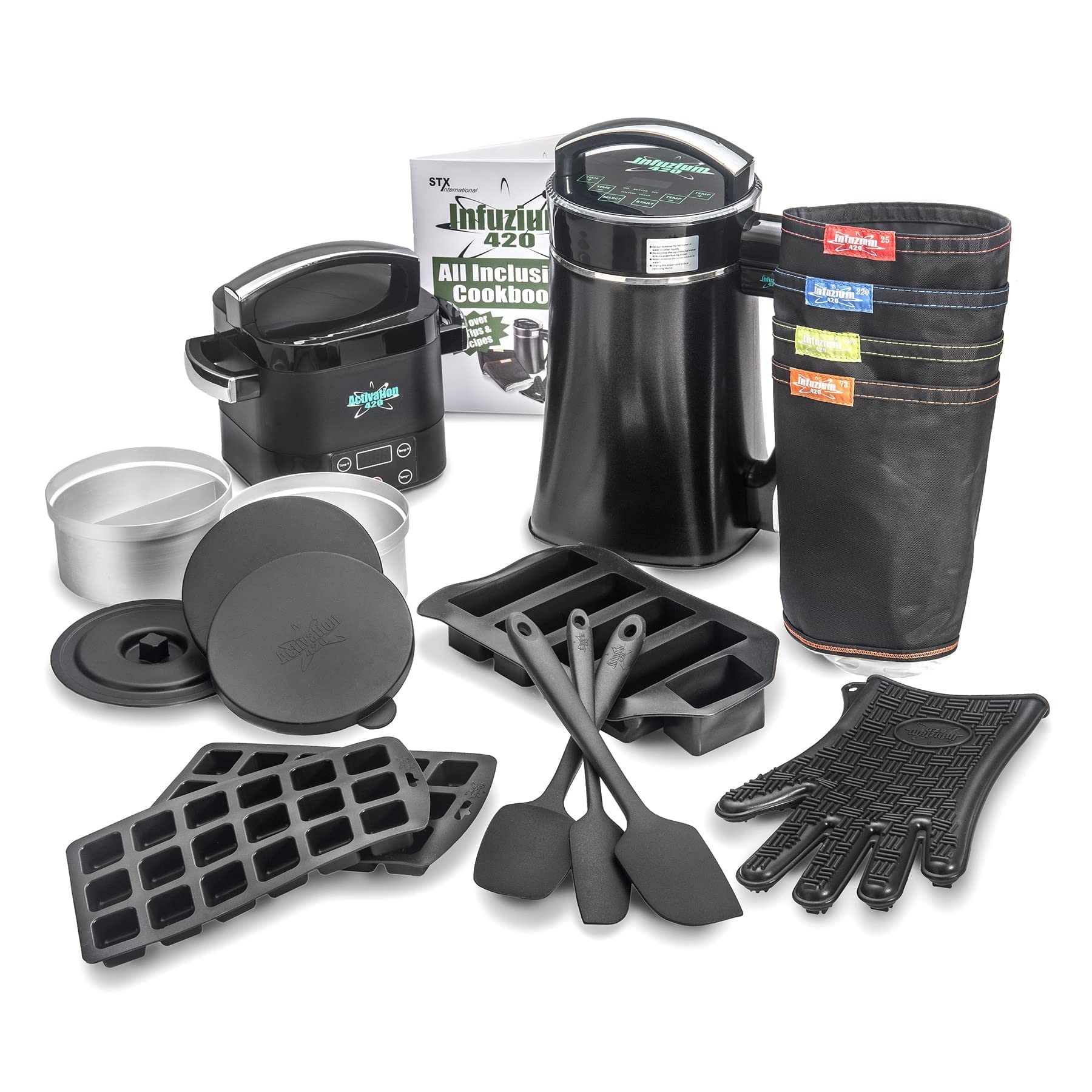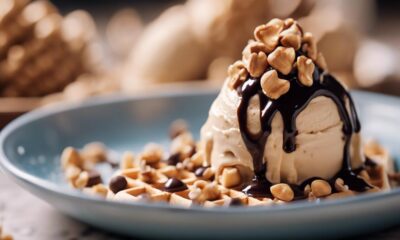Butter Basics
Delicious Spread: How to Make Fig Butter at Home!
Simple and tasty, discover how to make fig butter at home with easy steps and creative variations that will leave you craving more!
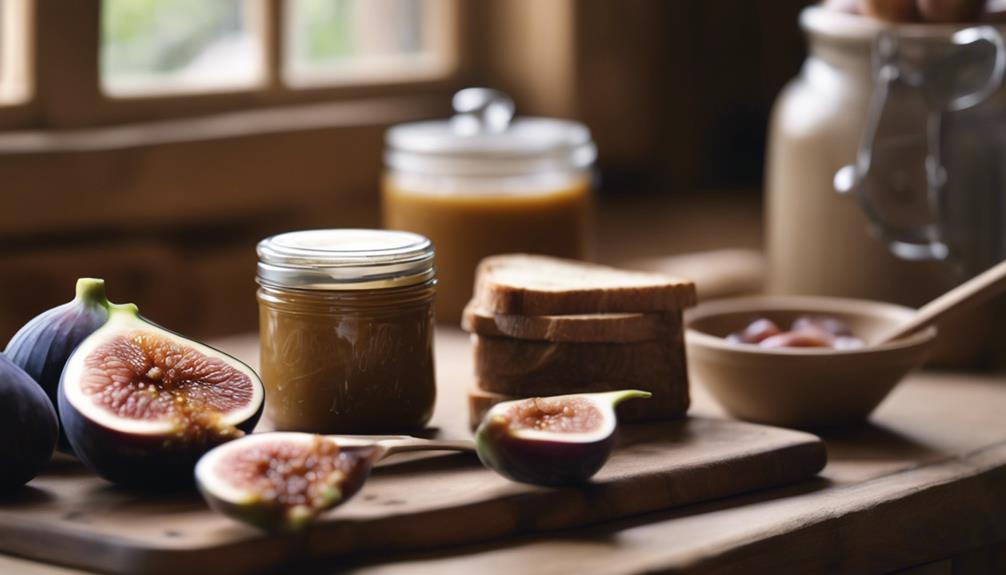
You'll love making fig butter at home because it's simple and delicious. Start by washing and chopping fresh figs, then cook them with sugar, lemon juice, and water until they're soft. Blend the mixture until smooth and creamy. Store your fig butter in airtight containers in the fridge or freezer to keep it fresh. It's perfect on toast, in pastries, or even as a salad dressing. Customize your spread by adding different fruits or spices. If you want to explore the full recipe with step-by-step details and variations, your delightful kitchen adventure awaits!
Key Takeaways
- Wash, cut, and remove the stems from fresh figs before cooking.
- Cook figs with sugar, lemon juice, water, and butter until soft.
- Blend the cooked fig mixture to achieve a creamy consistency.
- Store fig butter in airtight containers in the refrigerator or freezer.
- Use fig butter on toast, pastries, or as a salad dressing for versatile enjoyment.
Ingredients Needed
To make fig butter at home, you'll need fresh figs, sugar, lemon juice, water, and butter. These ingredients form the foundation of a sweet and flavorful spread that can elevate your breakfast or snack game. Start with fresh figs as the primary ingredient. Their natural sweetness and texture are essential for the perfect fig butter recipe.
Next, you'll need sugar to balance the flavors and enhance the sweetness of the figs. Lemon juice is pivotal as it adds a tangy brightness that complements the figs and helps preserve the butter. Water is necessary to achieve the right consistency, ensuring your fig butter isn't too thick or too runny. Finally, butter adds a rich, creamy element to the spread, making it indulgent and smooth.
You can also customize your fig butter recipe by adding spices like cinnamon or nutmeg, or even fresh herbs for a unique twist. Proper storage in airtight containers allows the fig butter to last up to 2 weeks in the fridge or even longer in the freezer, ensuring you can enjoy this delicious spread whenever you like.
Fig Preparation
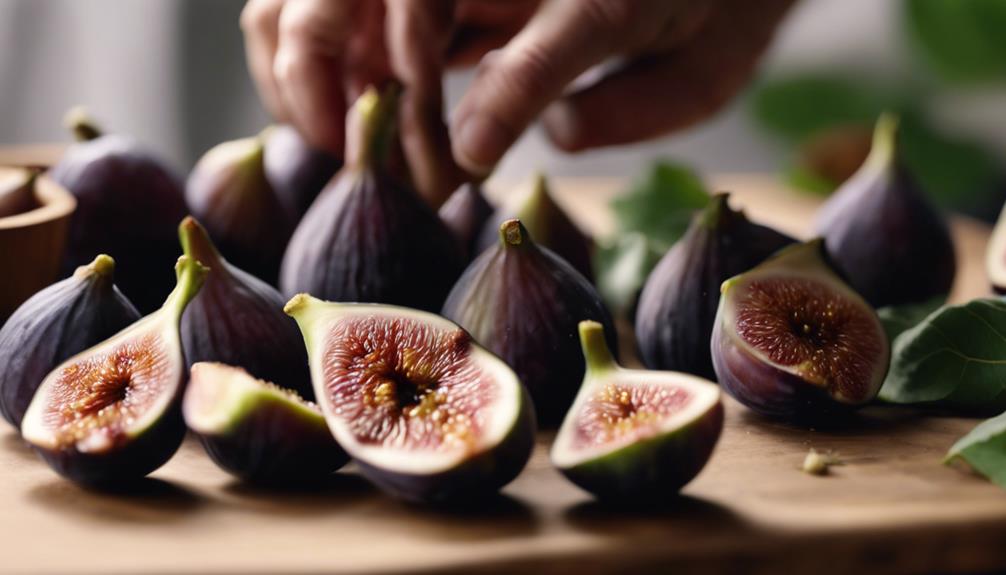
Start by rinsing the figs thoroughly to remove any dirt or residue.
Cut off the stems and decide whether to quarter or chop the figs for easier cooking.
Make sure you choose ripe, flavorful figs for the best taste in your fig butter.
Washing and Cutting
Before you begin making fig butter, make certain to wash the fresh figs under running water to remove any dirt and impurities. This step is essential to guarantee your fig butter is clean and safe to eat. Once the figs are thoroughly washed, gently pat them dry with a clean towel. Now you're ready to move on to cutting the figs.
Here are the steps for washing and cutting:
- Clean the figs: Hold each fig under running water, gently rubbing the skin to remove any dirt.
- Pat dry: Use a clean towel to gently pat dry the washed figs.
- Cut off the stem: Using a sharp knife, carefully cut off the stem end of each fig.
- Slice the figs: Depending on your recipe or preference, slice the figs in half or quarter them.
Stem Removal Technique
Removing the stems from the figs guarantees a smoother texture in your fig butter, enhancing the overall quality of your final product. Start by cutting off the stems at the top of each fig. This small step is essential for making sure that your fig butter recipe results in a creamy, lump-free spread. Making certain the stems are completely removed before blending prevents any hard bits from sneaking into your fruit butter.
Using an immersion blender, once the stems are off the figs, will help you achieve the desired consistency. All you need are ripe figs, as they are easier to work with and blend into a buttery consistency. Properly trimmed figs not only make the blending process smoother but also improve the overall texture of your fig butter.
Here's a quick reference table for the stem removal technique:
| Step | Description |
|---|---|
| 1 | Select ripe figs |
| 2 | Wash the figs thoroughly |
| 3 | Cut off the stems at the top of each fig |
| 4 | Confirm no stems remain before blending |
Choosing Fig Varieties
Selecting the appropriate fig varieties such as Black Mission, Brown Turkey, or Adriatic will guarantee your fig butter has the ideal flavor and texture. Each of these fig varieties offers a unique combination of sweetness and flavor intensity, which will influence the final taste of your butter.
- Black Mission Figs: Known for their deep purple skin and rich, sweet flavor, these figs are perfect if you want a deeply flavored fig butter.
- Brown Turkey Figs: These figs are milder and less sweet, making them a good choice if you prefer a more subtle fig butter.
- Adriatic Figs: With their light green skin and sweet, honey-like taste, Adriatic figs produce a lighter, more delicate fig butter.
- Ripe Figs: Ensure your figs are ripe but not overripe for optimal flavor and texture. Overripe figs can make the butter too mushy and overly sweet.
Proper fig preparation is essential. Start by washing the figs thoroughly to remove any dirt or pesticides. Next, remove stems carefully to avoid any bitterness in your spread. This step guarantees a smooth, silky texture in your fig butter.
When you take the time to choose and prepare your figs properly, you'll end up with a delicious, high-quality fig butter that's perfect for any occasion.
Cooking Process
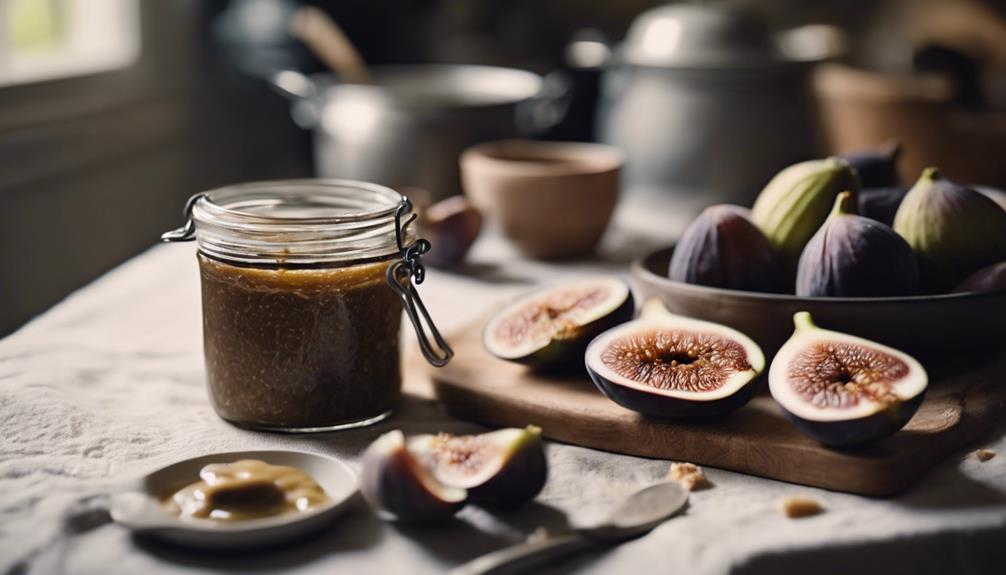
Start by washing and chopping fresh figs before combining them with sugar, lemon juice, and water in a saucepan. This is the first step in creating your delicious homemade fig butter.
As you stir the mixture, you'll notice the figs begin to break down. Keep the heat at a medium level to guarantee an even cooking process.
The goal is to cook the figs until they're soft and tender, which usually takes about 20-30 minutes. During this time, the sugar will dissolve, and the lemon juice will enhance the flavor, while the water helps keep everything from sticking to the pan. Stir occasionally to prevent any burning.
Once the figs are soft, you're ready to move on to the next step, which involves blending the mixture. But for now, focus on making sure your fig butter base is well-cooked.
You'll know it's ready when the figs become mushy and the mixture has thickened slightly. This cooking process is crucial for achieving that perfect spread consistency.
Blending Fig Mixture
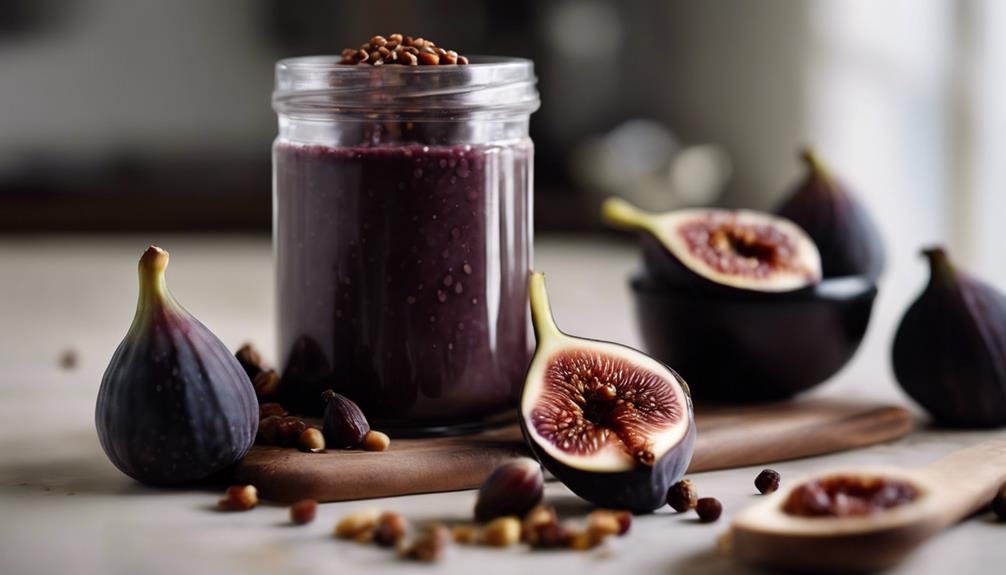
With your figs now perfectly cooked and tender, it's time to blend the mixture until smooth and creamy. Grab your blender or immersion blender and get ready to transform those soft figs into a silky, spreadable delight.
Here's how you can achieve the perfect creamy consistency:
- Prepare your blender: Make sure your blender or immersion blender is clean and ready to use. A high-powered blender works best for achieving a smooth texture.
- Blend the fig mixture: Carefully pour the cooked fig mixture into the blender. Blend on a medium setting, gradually increasing the speed. This helps to break down any remaining fig chunks.
- Check the consistency: Stop blending occasionally to check the consistency. If you prefer a chunkier texture, blend for less time. For a smoother, more spreadable fig butter, blend until you reach a creamy consistency.
- Adjust as needed: If the mixture is too thick, you can add a small amount of water or apple juice to help it blend more easily. Continue blending until all the figs are fully incorporated and the mixture is uniformly smooth.
Storing Fig Butter
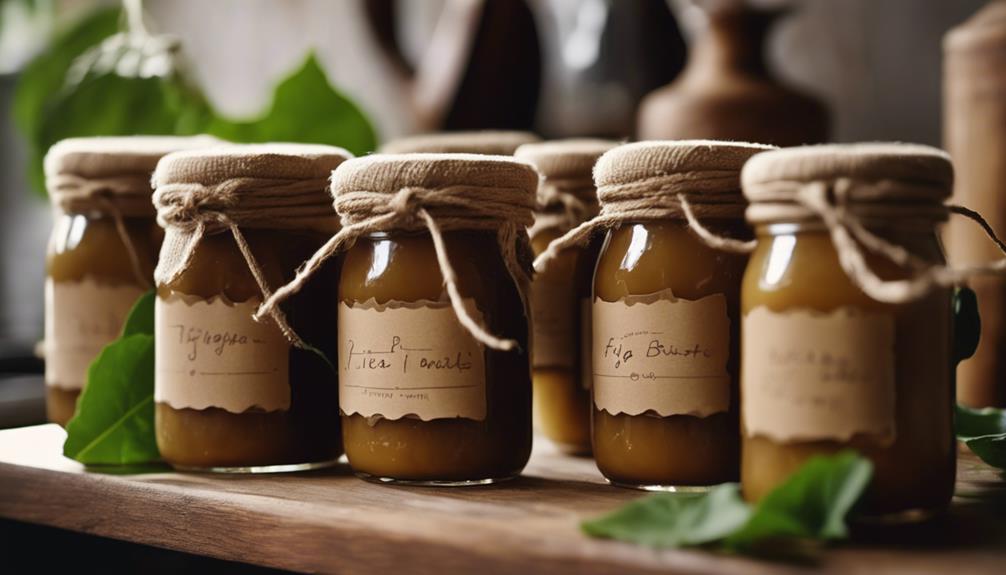
Secure your delectable fig butter stays fresh by storing it in airtight containers in the refrigerator. This will keep it delicious and ready to use for up to two weeks. Proper storage is key to maintaining the flavor and quality of your fig butter, so make certain the containers are well-sealed to prevent any air from getting in.
If you want to keep your fig butter for a longer period, consider freezing it. Use freezer-safe containers to store your fig butter in the freezer. When you're ready to use it, simply let it come to room temperature. This guarantees that the texture and taste remain consistent.
Don't forget to give it a good stir before serving to bring back its smooth, spreadable consistency.
Uses for Fig Butter
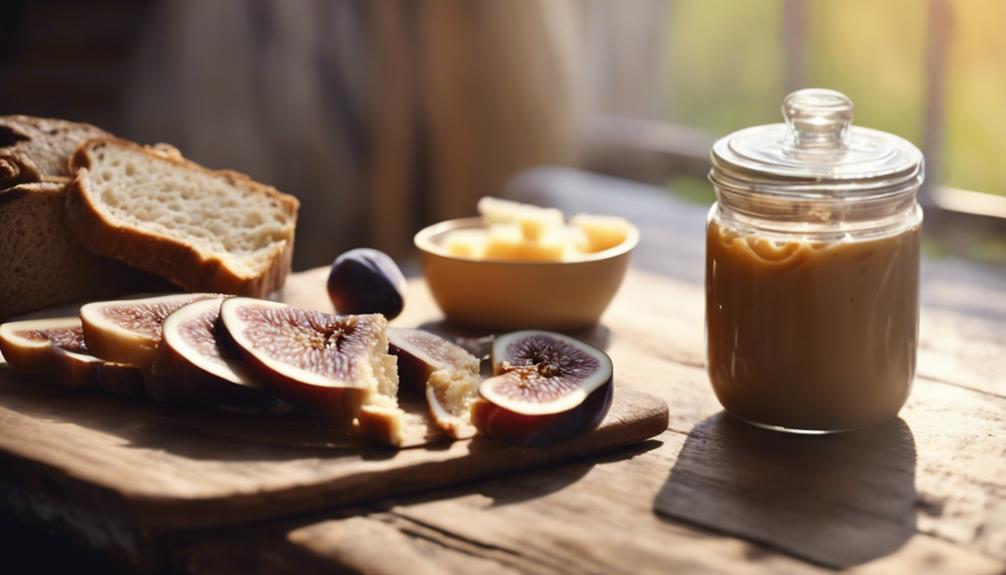
Now that you've mastered making fig butter, let's explore its versatile uses.
Spread it on toast or muffins, or use it to fill pastries and cookies.
You can also pair it with cheese or drizzle it over ice cream for a delicious treat.
Versatile Spread Ideas
Fig butter is a versatile spread that can elevate a variety of dishes, from breakfast staples to gourmet desserts. Imagine the sweet, fruity flavor of fig butter enhancing your favorite foods. Here are some ideas to get you started:
- Breakfast Boost: Spread fig butter on toast, muffins, or bagels to add a sweet and fruity note to your morning routine.
- Perfect Pastries: Incorporate fig butter into pastries like croissants, tarts, or turnovers for a delicious and unique filling that'll impress any guest.
- Charcuterie Board Delight: Pair fig butter with cheeses on a charcuterie board. The combination of sweet fig butter and savory cheese makes for a memorable appetizer.
- Savory Enhancer: Use fig butter to create flavorful salad dressings or marinades. It pairs particularly well with meats like chicken or pork, adding a rich depth to your dishes.
These versatile ideas show how fig butter can seamlessly fit into various culinary creations. Whether you're spreading it on your morning toast or using it in a sophisticated appetizer, fig butter adds a unique flavor that's sure to be a hit.
Cooking and Baking Uses
When it comes to cooking and baking, fig butter offers a multitude of delicious possibilities. You can use it as a spread on your morning toast, muffins, or bagels for a sweet and fruity start to your day. But don't stop there—fig butter shines in a variety of baking applications. Try using it as a filling for pastries, cakes, or cookies to infuse your desserts with rich flavor.
For a savory twist, pair fig butter with cheese on a charcuterie board. The combination of sweet fig butter and savory cheese creates an irresistible harmony that's perfect for entertaining. Looking to elevate your salads? Create unique salad dressings by incorporating fig butter for a touch of sweetness and depth of flavor.
Here's how you can use fig butter in your kitchen:
| Use | Description |
|---|---|
| Spread | Perfect on toast, muffins, or bagels. |
| Baking | Use as a filling for pastries, cakes, cookies |
| Cheese Pairing | Ideal for charcuterie boards |
| Salad Dressings | Adds sweetness and depth to dressings |
Lastly, don't forget to drizzle fig butter over ice cream or yogurt for a delicious and indulgent treat. With fig butter, your cooking and baking possibilities are endless!
Recipe Variations
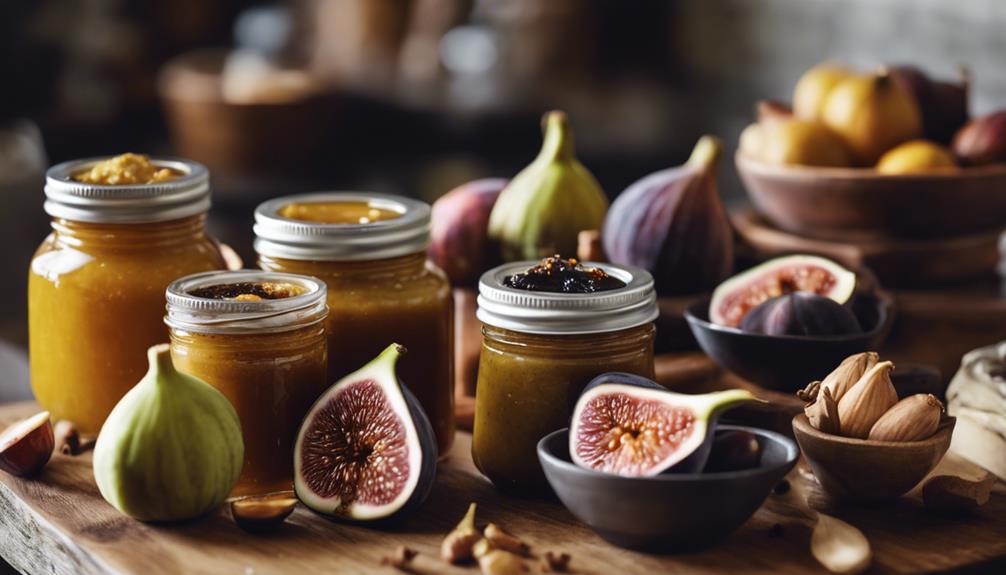
For a delightful twist on traditional fig butter, consider experimenting with spices, herbs, and different types of figs. These variations can elevate the flavor and texture of your homemade spread, making it a unique culinary experience. By adding a few simple ingredients, you can transform your fig butter into a gourmet treat.
Here are four ways to enhance your fig butter:
- Spices: Incorporate warming spices like cinnamon or nutmeg. These spices add depth and a cozy aroma to your fig butter, making it perfect for fall and winter.
- Herbs: Infuse your fig butter with aromatic herbs like rosemary or thyme. These herbs introduce a savory note, balancing the sweetness of the figs with an invigorating twist.
- Texture: Mix in chopped nuts such as walnuts or pecans. The added crunch provides a delightful contrast to the smooth fig butter, creating a more complex and satisfying texture.
- Different Figs: Experiment with various types of figs like Black Mission, Brown Turkey, or Kadota. Each variety offers a unique flavor profile, allowing you to customize your fig butter to your taste preference.
Doubling the Recipe
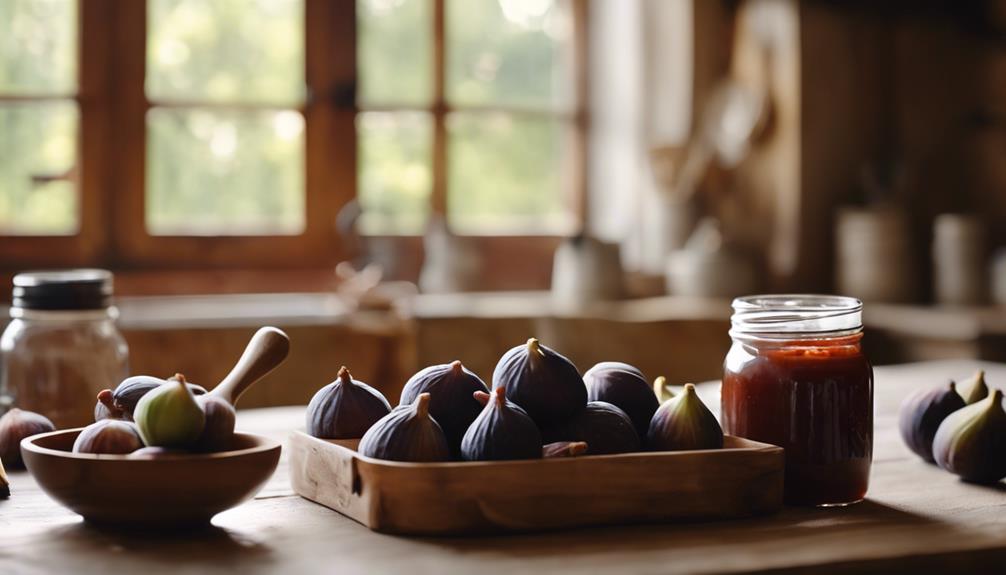
Doubling your fig butter recipe means you can enjoy this delicious spread for longer while also having some to share. When you decide to double the recipe, make sure to use two slow cookers to ensure even cooking and consistency. It's vital to adjust ingredients properly so that you maintain the desired sweetness and flavor profile.
Consider freezing extra batches of fig butter if you end up with more than you need immediately. This way, you'll always have a stash ready for later. Don't be afraid to experiment with different fruit combinations or spices when making a larger batch. This can add variety and keep things interesting.
One important tip is to monitor the cooking time closely. When you double the recipe, the slow cookers might need adjustments in cooking duration to prevent burning or overcooking. Here's a quick guide to help you with these adjustments:
| Aspect | Single Batch | Double Batch |
|---|---|---|
| Slow Cooker | 1 | 2 |
| Ingredient Adjustment | Standard | Double |
| Freezing | Optional | Recommended |
| Cooking Time | Standard | Monitor Closely |
Doubling the recipe can be a fun and rewarding process, providing you with extra fig butter to enjoy and share!
Fig Butter Benefits

Fig butter not only delights your taste buds but also packs a nutritious punch with its high fiber, minerals, antioxidants, and vitamins. When you make homemade fig butter, you control the ingredients, ensuring a healthier spread without unnecessary additives.
Here are some incredible fig butter benefits you'll enjoy:
- Nutrient-Rich: Fig butter is loaded with essential nutrients like calcium, potassium, and magnesium, which support bone health and muscle function.
- High in Fiber: The high fiber content aids digestion and helps maintain a healthy gut, making it an excellent choice for a nutritious diet.
- Antioxidant Boost: Figs are rich in antioxidants that fight free radicals, reducing inflammation and promoting overall well-being.
- Versatile Flavors: Homemade fig butter allows you to experiment with diverse flavors by adding spices, herbs, or nuts. This versatility makes it a delightful addition to various dishes.
Enjoy this spread on toast, biscuits, or scones, or get creative by using it as a pastry filling. Pair it with cheese on a charcuterie board, mix it into salad dressings, or drizzle it over ice cream. Embrace the fig butter benefits and savor its nutritious and delicious flavors in every bite!
Frequently Asked Questions
What Is Fig Butter Made Of?
You make fig butter from fresh figs, sugar, lemon juice, water, and butter. The figs and sugar give it sweetness, while lemon juice adds tanginess. Water softens the figs, and butter makes it rich and creamy.
What Is the Difference Between Fig Butter and Fig Preserves?
Did you know fig butter contains 50% more fiber than fig preserves? Fig butter has a smooth, creamy consistency, while fig preserves are chunkier with visible fruit pieces. Both are delicious, but texture and appearance differ.
Does Fig Butter Need to Be Refrigerated?
Yes, you need to refrigerate fig butter to keep it fresh and prevent spoilage. Store it in an airtight container in the fridge, and remember to stir well and bring it to room temperature before serving.
What Is Fig Spread Made Of?
Fig spread's made of fresh figs, sugar, lemon juice, and water. You can add butter for creaminess and experiment with spices like cinnamon or nutmeg, or herbs like rosemary for unique flavors. Different figs give diverse textures.
Conclusion
You've now got the know-how to whip up fig butter right at home. Imagine spreading this sweet, velvety delight on your morning toast—did you know that just one tablespoon of fig butter packs as much fiber as a small apple?
It's not only delicious but also a nutritious way to start your day. So, pull out those figs and let's get cooking; your taste buds will thank you!
From sneaky childhood butter licks to penning some of our most popular articles, Jamie’s journey with butter has been lifelong. His culinary background gives him a unique perspective, allowing him to craft mouthwatering articles that educate and tantalize equally. Jamie’s travel adventures revolve around finding the world’s best buttery treats when he isn’t writing.
Butter Basics
Why is Melted Butter Called Drawn Butter?
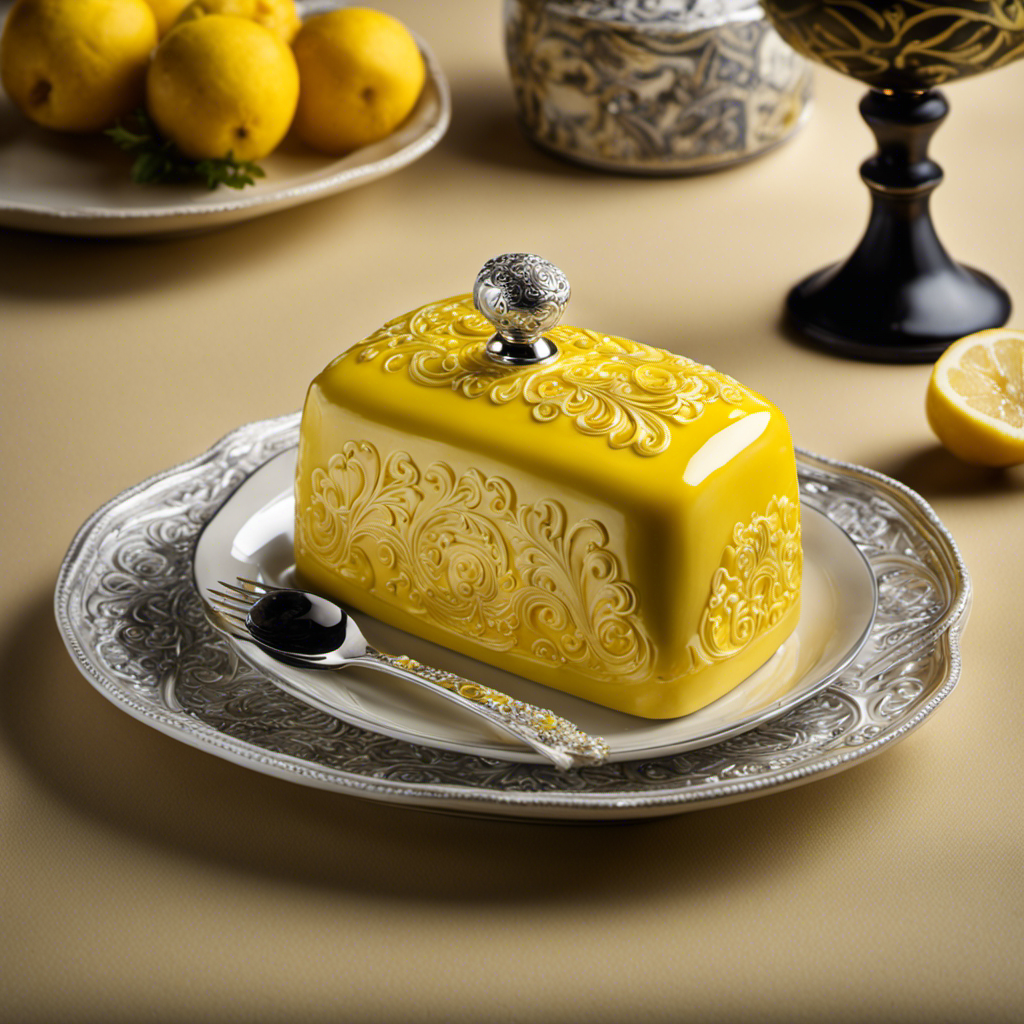
Did you know that clarified butter, a crucial component in many dishes, has a fascinating origin story behind its name? In this article, we will delve into the origins, significance, and various uses of clarified butter.
We will explore the regional variations and even learn how to make the perfect batch at home. Join me as we uncover the intriguing story of why it is called drawn butter and discover the secrets behind this delectable condiment.
Key Takeaways
- The term ‘drawn butter’ refers to the process of extracting butter from cream.
- Drawn butter is a staple in many Western culinary dishes, commonly used as a sauce or topping for seafood or vegetables.
- Clarified butter has historical origins in ancient civilizations and continues to hold cultural significance in many parts of the world.
- Drawn butter has various culinary uses and benefits, including being a cooking fat, moisturizer for the skin, and suitable for those with lactose intolerance or dairy allergies.
The Origins of "Drawn Butter
I’ve always wondered about the origins of ‘drawn butter’ and why it’s called that. After conducting some research, I discovered that the term ‘drawn butter’ refers to the process of extracting butter from cream. This process involves removing the cream from milk and then churning it until the fat separates from the liquid, resulting in butter. The term ‘drawn’ comes from the Old English word ‘dragan,’ which means to extract or pull out.
The cultural associations of drawn butter are also interesting. In many Western cultures, drawn butter is commonly used as a sauce or topping for various dishes, such as seafood or vegetables. It adds a rich, creamy flavor that complements the flavors of the dish. Additionally, drawn butter is often associated with indulgence, luxury, and fine dining, as it’s a classic accompaniment to special meals.
Overall, the origins of ‘drawn butter’ lie in the process of butter extraction, while its cultural associations highlight its culinary significance and decadent nature.
Historical Significance of "Drawn Butter
I’ve always been fascinated by the historical significance of this rich and savory sauce commonly known as clarified butter.
The historical origins of clarified butter can be traced back to ancient civilizations such as Egypt and India. In these cultures, butter was used not only for culinary purposes but also for medicinal and religious rituals. The process of clarifying butter was developed as a way to preserve it for longer periods of time.
Over time, this technique spread to other regions, such as Europe, where it became an integral part of traditional cuisine. Today, clarified butter continues to hold cultural significance in many parts of the world.
In Indian cuisine, it’s used in religious ceremonies and is considered a symbol of purity. In French cuisine, it’s a key ingredient in classic dishes such as hollandaise sauce.
The historical origins and cultural significance of clarified butter make it a truly fascinating culinary ingredient.
Culinary Uses for Drawn Butter
Growing up, my family often used clarified butter as a delicious and versatile ingredient in our cooking. While most commonly used as a cooking fat, there are several alternative uses for clarified butter that many people may not be aware of.
One alternative use for clarified butter is as a moisturizer for the skin. Due to its high concentration of vitamins and fatty acids, it can help nourish and hydrate the skin, leaving it soft and smooth.
Additionally, clarified butter can be used as a hair conditioner to promote shine and reduce frizz. In terms of health benefits, clarified butter is rich in healthy fats and contains no lactose or casein, making it a suitable option for those with lactose intolerance or dairy allergies.
It also has a higher smoke point than regular butter, making it a safer choice for high-heat cooking methods. Overall, clarified butter isn’t only a versatile ingredient in the kitchen, but it also offers various health and beauty benefits.
Variations and Regional Names of Drawn Butter
One popular variation of clarified butter is ghee, which is commonly used in Indian cuisine. Ghee is made by simmering butter and removing the milk solids, resulting in a rich and nutty flavor.
However, regional differences in the preparation of clarified butter can be found all around the world. In the Middle East, it’s known as samneh and is used in dishes like hummus and baklava.
In France, clarified butter is called beurre noisette and is used to enhance the flavor of dishes like sole meunière.
In North America, drawn butter is commonly served with seafood, such as lobster and crab.
Each regional variation adds its own unique touch to popular dishes, showcasing the versatility and adaptability of this beloved ingredient.
How to Make Perfect Drawn Butter at Home
To achieve a perfect homemade clarified butter, simmer the butter on low heat and carefully remove the milk solids for a smooth and flavorful result.
Clarified butter, also known as drawn butter, is a form of butter that has had the milk solids and water removed, leaving behind only the pure butterfat. This process not only enhances the butter’s shelf life but also increases its smoke point, making it ideal for high-heat cooking methods like sautéing and frying.
The benefits of using clarified butter extend beyond its practicality in the kitchen. It has a rich and nutty flavor, making it a delicious addition to a variety of dishes. Additionally, it contains no lactose or casein, making it suitable for those with lactose intolerance or milk allergies.
Clarified butter is also commonly used in traditional Ayurvedic medicine for its alleged health benefits, such as improving digestion and promoting overall wellness.
Frequently Asked Questions
What Is the Nutritional Value of Drawn Butter?
The nutritional value of drawn butter depends on the quality of the butter used. Butter is a good source of healthy fats, vitamins A, D, E, and K, and minerals like calcium.
Drawn butter, also known as clarified butter, is made by separating the milk solids from the butterfat. This process removes lactose and casein, making it suitable for lactose-intolerant individuals.
Drawn butter is often used in cooking techniques like sautéing and basting, adding flavor and richness to dishes.
Can Drawn Butter Be Used as a Substitute for Regular Butter in Recipes?
Yes, drawn butter can be used as a substitute for regular butter in recipes. It adds a rich and creamy flavor to dishes, especially seafood. While some may argue that drawn butter has a higher fat content, it can still be enjoyed in moderation.
Cooking with drawn butter can elevate the taste of your dishes, giving them a luxurious touch. So go ahead and experiment with substituting regular butter with drawn butter in your favorite recipes.
Are There Any Health Benefits Associated With Consuming Drawn Butter?
There are no specific health benefits associated with consuming drawn butter.
However, it’s important to note that drawn butter is high in saturated fat and cholesterol, which can increase the risk of heart disease when consumed in excess.
If you’re looking for healthier alternatives, consider using olive oil or avocado as substitutes for butter in recipes.
These options provide healthier fats and can still achieve a similar flavor and texture in your dishes.
What Are Some Common Misconceptions About Drawn Butter?
There are several common misconceptions about drawn butter that I’d like to address.
One myth is that it’s unhealthy due to its high fat content. While it’s true that drawn butter contains a significant amount of fat, it can be enjoyed in moderation as part of a balanced diet.
Another misconception is that drawn butter is difficult to make. In reality, it’s a simple process of melting and separating the milk solids from the butterfat.
Are There Any Cultural or Traditional Uses for Drawn Butter Outside of Culinary Purposes?
Cultural significance and historical uses of drawn butter extend beyond the culinary realm. One fascinating statistic is that in Scandinavian culture, drawn butter plays a significant role in their traditional Midsummer celebration.
During this festive event, butter is melted and drizzled over potatoes and fish, symbolizing abundance and prosperity. This cultural tradition showcases how drawn butter isn’t only a delicious culinary ingredient, but also a symbol of cultural heritage and celebration.
Conclusion
In conclusion, the term ‘drawn butter’ has its origins in the process of clarifying butter, which involves separating the milk solids from the pure butterfat.
This clarified butter has a smooth and rich texture, making it ideal for dipping seafood, drizzling over vegetables, or adding flavor to various dishes.
Just like the process of clarifying butter, we too can strive to remove any impurities or distractions in our lives, allowing us to fully enjoy the richness and simplicity of each moment.
From sneaky childhood butter licks to penning some of our most popular articles, Jamie’s journey with butter has been lifelong. His culinary background gives him a unique perspective, allowing him to craft mouthwatering articles that educate and tantalize equally. Jamie’s travel adventures revolve around finding the world’s best buttery treats when he isn’t writing.
Butter Basics
How Butter Turns Yellow: A Simple Guide
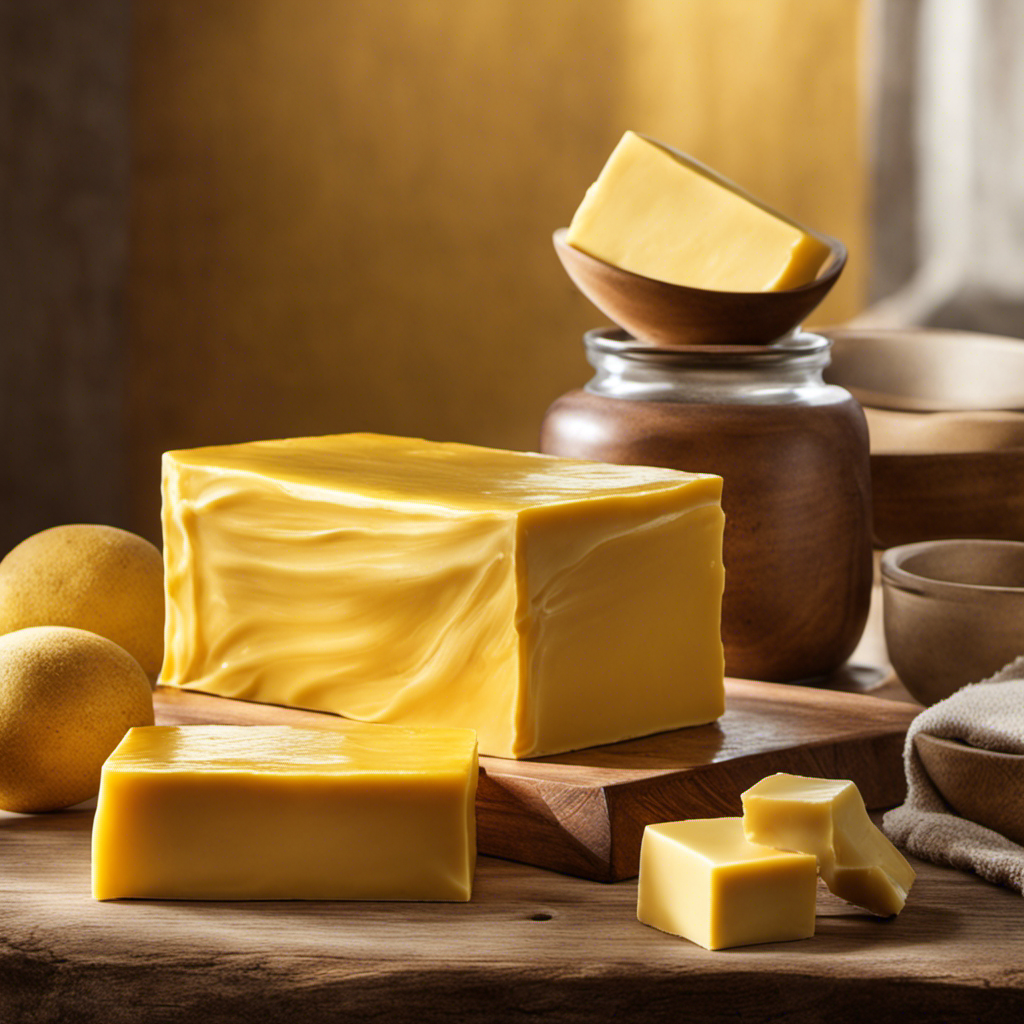
Have you ever wondered why butter has the same yellow color as a sunflower field? I’ve got the scoop for you!
In this article, we’ll dive deep into the science behind butter’s vibrant hue. We’ll explore the role of carotenoids in giving butter its yellow color and how a cow’s diet plays a crucial role in this process.
Join me as we uncover the secrets behind butter’s golden glow and discover why it’s not just a pretty color, but a sign of quality too.
Key Takeaways
- Butter gets its yellow color from a natural pigment called beta-carotene.
- Carotenoids, such as beta-carotene, lutein, and zeaxanthin, are responsible for giving butter its distinctive yellow hue.
- A diet rich in carotenoids can reduce the risk of chronic diseases like heart disease and certain types of cancer.
- Factors like sunlight exposure, cow breed, grass type, and extraction techniques can affect the amount and intensity of carotenoids in butter, influencing its final color.
The Science Behind Butter’s Yellow Color
Did you know that butter is yellow because of a natural pigment called beta-carotene? Beta-carotene is a type of carotenoid, a pigment found in fruits, vegetables, and plants. When cows eat grass, they consume carotenoids, which get absorbed into their bloodstream. These carotenoids then travel to the cow’s mammary glands and become part of the milk fat.
During the butter-making process, the milk is churned, causing the fat globules to rupture. This rupture releases the beta-carotene, which undergoes chemical reactions. These reactions lead to the formation of compounds that give butter its distinct yellow color. The amount of beta-carotene in the butter can vary depending on factors like the cow’s diet and breed, resulting in different shades of yellow.
The Role of Carotenoids in Butter’s Hue
When it comes to the yellow color of butter, one key player is carotenoids. Carotenoids are natural pigments that can be found in various fruits, vegetables, and even some animal products.
In butter, carotenoids are responsible for giving it that distinctive yellow hue.
Carotenoids and Yellow Color
Carotenoids are what give butter its yellow color. These natural pigments are found in various fruits and vegetables and are known for their health benefits. Here are five key points about carotenoids and their impact on human health:
- Carotenoids are powerful antioxidants that help protect our cells from damage caused by free radicals.
- Studies have shown that a diet rich in carotenoids can reduce the risk of chronic diseases, such as heart disease and certain types of cancer.
- Carotenoids, such as beta-carotene, lutein, and zeaxanthin, are important for maintaining healthy vision and preventing age-related macular degeneration.
- Including carotenoid-rich foods in our diet, such as carrots, sweet potatoes, spinach, and tomatoes, can help boost our intake of these beneficial compounds.
- Incorporating carotenoid-rich recipes, such as a colorful vegetable stir-fry or a vibrant tomato soup, can not only enhance the taste but also provide us with an array of health benefits.
Butter’s Natural Pigments
The natural pigments found in butter give it a distinct color. One of the main factors that influences the color of butter is sunlight. When cows graze on fresh grass, they consume carotenoids, which are natural pigments found in plants. These carotenoids are then metabolized by the cow’s body and are incorporated into the butterfat. Sunlight exposure can enhance the color of these carotenoids, resulting in a deeper yellow hue in the butter.
Additionally, genetic factors also play a role in determining the color of butter. Certain breeds of cows, such as Jersey and Guernsey, naturally produce milk with a higher concentration of carotenoids, leading to a richer yellow color in the butter.
Influence of Carotenoids
You can enhance the color of butter by exposing it to sunlight. The color of butter is influenced by the presence of carotenoids, which are natural pigments found in plants. These carotenoids can be extracted from certain plants and used to enhance the color of butter.
The influence of climate on the color of butter is significant, as the amount of carotenoids in plants can vary depending on factors such as temperature and sunlight exposure. Additionally, carotenoid extraction techniques play a crucial role in determining the color of butter. Different extraction methods can yield varying amounts of carotenoids, which in turn affect the final color of the butter.
Therefore, both climate and extraction techniques are essential factors to consider when aiming to achieve a desired color for butter.
- Climate: Temperature and sunlight exposure affect the amount of carotenoids in plants.
- Carotenoid Extraction Techniques: Different methods yield varying amounts of carotenoids.
- Butter Color Enhancement: Sunlight exposure can enhance the color of butter.
- Natural Pigments: Carotenoids are natural pigments found in plants.
- Importance of Carotenoids: Carotenoids play a crucial role in determining the color of butter.
How Cows’ Diet Affects Butter’s Color
When it comes to the color of butter, the diet of cows plays a crucial role. One key factor is the type of grass that cows consume. Certain grasses, such as those high in carotenoids, can lead to a richer yellow hue in the butter.
Additionally, the pigments found in the cows’ diet, such as beta-carotene, can be transferred to the milk and ultimately affect the color of the butter.
This connection between cow grass and butter, as well as the pigments in their diet, sheds light on the mystery of why butter is yellow.
Cow Grass and Butter
Why is butter yellow? It’s because cows eat grass. When cows graze on grass, they consume a pigment called carotene found in the plants. This pigment is then stored in their body fat, which includes the milk they produce.
During the butter production process, cream is separated from the milk and churned to separate the fat and water content. The fat in the cream contains the carotene, giving butter its yellow color.
Here are five key points to consider:
- Cows’ diet largely consists of grass, which contains carotene.
- Carotene is a pigment that gives butter its yellow color.
- The carotene is stored in the cow’s body fat, which includes their milk.
- Cream is separated from the milk during the butter production process.
- The fat in the cream contains the carotene, resulting in yellow butter.
Pigments in Cow’s Diet
In my previous discussion about cow grass and butter, I explored how the diet of cows can affect the color of the butter they produce. Now, let’s delve deeper into the pigments in a cow’s diet that contribute to the yellow color of butter.
One of the key compounds responsible for this vibrant hue is carotenoids. Carotenoids are natural pigments found in plants, and when cows consume grass or forage that contains these pigments, they get incorporated into their milk fat. As a result, the butter produced from this milk takes on a yellowish tint.
The presence of carotenoids in a cow’s diet can vary depending on factors such as the season and the type of forage available. Understanding the relationship between diet and butter pigments is crucial in unraveling the yellow butter mystery.
Now, let’s explore the factors that contribute to the enigma of yellow butter.
Yellow Butter Mystery
The mystery behind the yellow hue of butter is still being investigated. While butter is typically pale yellow, the intensity of the color can vary depending on factors such as the cow’s diet and breed. Here are some key aspects to consider when exploring the origin of butter’s yellow color and its historical significance:
-
Genetic variation: Certain cow breeds naturally produce milk with a higher concentration of beta-carotene, a pigment responsible for the yellow color.
-
Diet: Cows that graze on fresh grass or eat hay with high carotene content are more likely to produce yellow butter.
-
Processing methods: The churning process can also influence the color of butter, with longer churning times resulting in a deeper yellow hue.
-
Historical context: Traditional butter-making methods involved using milk from cows grazing on nutrient-rich pastures, which contributed to the yellow color.
-
Consumer preference: Over time, consumers have come to associate the yellow color with higher quality and taste, leading to the popularity of yellow butter.
Understanding the origin and history of yellow butter adds an interesting layer to the ongoing investigation of its yellow hue.
The Impact of Grass-Fed Vs Grain-Fed Diet on Butter’s Hue
When you choose to feed cows grass instead of grain, the butter they produce will likely have a more vibrant yellow hue. This is because grass contains higher levels of carotenoids, which are natural pigments responsible for the yellow color in butter. Carotenoids are fat-soluble compounds that are found in plants, and when cows consume grass, these compounds are absorbed into their bloodstream and ultimately accumulate in their milk fat. Grass-fed cows have been shown to produce butter with higher levels of carotenoids compared to grain-fed cows. This not only gives the butter its distinct yellow color, but it also provides nutritional benefits. Carotenoids are known for their antioxidant properties and have been linked to various health benefits, including improved eye health and reduced risk of chronic diseases.
To further emphasize the impact of grass-fed vs grain-fed diets on the color and nutritional benefits of butter, let’s take a look at the following table:
| Grass-Fed Diet | Grain-Fed Diet |
|---|---|
| Higher levels of carotenoids | Lower levels of carotenoids |
| Vibrant yellow hue | Pale yellow hue |
| Rich in antioxidants | Lower antioxidant content |
| Nutritional benefits | Potential nutritional deficiencies |
As you can see, feeding cows grass results in butter that is not only visually appealing with its vibrant yellow hue, but also offers higher levels of antioxidants and potential nutritional benefits compared to butter produced from grain-fed cows.
The Role of Beta-Carotene in Butter’s Yellow Shade
To achieve that vibrant hue in your butter, it’s important to understand the role beta-carotene plays. Beta-carotene is a carotenoid pigment found in plants that can be converted into Vitamin A by our bodies. In the case of butter, the yellow color is a result of the cow’s diet and the carotenoids present in the grass they consume.
Here are some key points to consider about carotenoid synthesis and butter color genetics:
- Carotenoids are synthesized by plants through a process called carotenogenesis.
- The intensity of the yellow color in butter depends on the amount of beta-carotene present.
- Certain breeds of cows have a genetic predisposition to produce more yellow pigment in their milk.
- Grass-fed cows have a higher intake of carotenoids, resulting in a deeper yellow color in their butter.
- Butter made from grain-fed cows may be paler in color due to the lower carotenoid content in their diet.
Understanding the role of beta-carotene and the impact of diet on butter color genetics can help you achieve that desired vibrant shade in your butter.
The Influence of Processing Methods on Butter’s Color
Processing methods can affect the color of butter, with certain techniques resulting in a more vibrant hue. One such method is carotenoid extraction, commonly used in industrial processing. Carotenoids are natural pigments found in plants and are responsible for the yellow color of butter. During the extraction process, these pigments are separated from the butterfat, resulting in a paler shade.
However, not all processing methods involve carotenoid extraction. Some techniques, such as churning at higher speeds or using cultures with higher carotene content, can enhance the yellow color.
Additionally, the type of cow’s diet can also impact the color of butter. Cows that graze on fresh grass produce milk with higher levels of carotenoids, resulting in a more golden butter.
Factors That Can Alter Butter’s Yellow Pigment
When discussing the factors that can alter butter’s yellow pigment, it’s important to consider the use of natural versus artificial coloring and the diet of dairy cows.
Natural coloring, such as carotenoids found in grass-fed cows, can contribute to the yellow color of butter. On the other hand, artificial coloring may be used to enhance or maintain the desired yellow hue.
Additionally, the diet of dairy cows, whether they’re fed a diet high in carotenoids or not, can also affect the color of the butter they produce.
Natural Versus Artificial Coloring
Why is butter yellow?
Well, you might be wondering about the difference between natural and artificial coloring. Natural coloring is derived from sources such as annatto, marigold flowers, or carrots, while artificial coloring is created in a laboratory.
The use of food dyes in butter can greatly influence its color, which in turn impacts consumer perception. Here are five key points to consider:
- Natural coloring can vary in intensity, resulting in shades of yellow ranging from pale to deep.
- Artificial coloring allows for more control over the desired shade of yellow.
- Some consumers prefer the vibrant color associated with artificial coloring, as it may indicate freshness.
- Others prefer the more subtle hue of naturally colored butter, perceiving it as a sign of a more wholesome product.
- The choice between natural and artificial coloring ultimately depends on personal preference and the desired perception of the butter product.
Diet of Dairy Cows
Dairy cows’ diets greatly impact the nutritional content of their milk. The same holds true for butter production. The feed that cows consume can influence the color, taste, and composition of the milk they produce. Different cow feeds contain varying levels of carotenoids, which are natural pigments responsible for the yellow color in butter. To understand the relationship between cow feed and butter production, let’s take a look at the table below:
| Cow Feed | Carotenoid Content |
|---|---|
| Grass | High |
| Corn | Low |
| Alfalfa | Moderate |
| Silage | Moderate |
| Soybean Meal | Low |
As you can see, cows that consume grass-based diets have higher carotenoid content, resulting in a more yellow-colored butter. This table highlights the importance of cow feed in determining the color and nutritional value of butter. In the next section, we will explore the relationship between butter’s color and its nutritional value.
The Relationship Between Butter’s Color and Nutritional Value
To understand the relationship between the color of butter and its nutritional value, you might want to consider factors like the cow’s diet and the presence of natural pigments. Here are five key points to consider:
-
The yellow color of butter is primarily due to the presence of carotenoids, which are pigments found in plants that cows consume. Carotenoids are a group of antioxidants that have numerous health benefits, including promoting eye health and reducing the risk of certain diseases.
-
The amount of carotenoids in butter can vary depending on the cow’s diet, with cows fed on fresh grass producing butter with higher levels of carotenoids.
-
The cultural significance of butter’s yellow color is evident in various cuisines, where it is often associated with richness, flavor, and quality.
-
While the color of butter does not necessarily indicate its nutritional value, butter with a deeper yellow hue may contain higher levels of carotenoids and potentially offer greater health benefits.
Butter’s Yellow Hue: A Sign of Quality
If you’re looking for a sign of quality in butter, one thing you can consider is the richness and vibrancy of its hue. The significance of butter’s hue goes beyond just aesthetics; it can tell us a lot about the butter’s composition and nutritional value. In fact, the yellow color of butter comes from the natural pigments found in the diet of dairy cows, specifically beta-carotene. This compound is abundant in fresh grass and is converted by the cow’s body into vitamin A. The cultural symbolism of yellow butter also plays a role in our perception of its quality. In many cultures, the color yellow is associated with sunshine, warmth, and richness, which adds to the appeal of yellow butter.
To give you a visual representation, here is a table showcasing the different hues of butter:
| Hue | Description |
|---|---|
| Pale Yellow | Subtle and light |
| Golden | Rich and vibrant |
| Deep Yellow | Intense and full-bodied |
| Amber | Luxurious and indulgent |
Natural Vs Artificial Colorants in Butter: Pros and Cons
Using natural colorants in butter has both advantages and disadvantages.
-
Natural colorants, such as annatto or turmeric, are derived from plants and are generally considered safe for consumption. These colorants can provide a vibrant and appealing yellow color to butter, making it visually appealing to consumers.
-
Consumer preferences for natural colorants in food products have been increasing due to concerns about the potential health risks associated with artificial colorants. Using natural colorants aligns with the growing demand for clean label products that are free from artificial additives.
-
However, the use of natural colorants can be more expensive and less consistent in achieving a desired color compared to artificial colorants.
Overall, while there are ethical concerns surrounding the use of artificial colorants and consumer preferences for natural alternatives, the decision to use natural colorants in butter comes with its own set of advantages and disadvantages.
Butter’s Yellow Color: A Cultural Perspective
From a cultural perspective, you may find it interesting to know that the vibrant color of butter is often associated with richness and quality. The yellow hue of butter has deep cultural significance and is rooted in historical traditions. Throughout history, yellow butter has been seen as a symbol of prosperity and abundance. In many cultures, the color yellow represents sunshine, warmth, and happiness, which are all qualities associated with butter. In fact, in some regions, the color of butter is regulated by strict standards to ensure its quality and authenticity. To further understand the cultural significance of butter’s yellow color, let’s take a look at the following table:
| Culture | Cultural Significance | Historical Traditions |
|---|---|---|
| European | Symbol of wealth and prosperity | Traditionally churned from cream |
| Indian | Symbol of purity and spirituality | Used in religious ceremonies |
| American | Signifies farm-fresh, natural | Historical association with dairy farms |
| Asian | Associated with good fortune | Used in traditional cooking and rituals |
| African | Symbolic of community and sharing | Traditional ingredient in communal meals |
As you can see, the cultural significance of butter’s yellow color varies across different cultures, but it consistently represents qualities such as wealth, purity, and good fortune. These historical traditions have shaped our perception of butter and its color, making it an important aspect of culinary and cultural heritage.
Frequently Asked Questions
What Other Factors Besides Carotenoids Can Affect the Yellow Color of Butter?
Other factors, such as the butter color analysis, reveal that the yellow color of butter can also be influenced by natural or artificial colorants used in production.
Does the Nutritional Value of Butter Change Depending on Its Yellow Hue?
The nutritional value of butter does not change based on its yellow hue. The color comes from carotenoids in the cow’s diet, but it doesn’t affect the butter’s nutrients.
Are There Any Health Benefits Associated With Consuming Yellow Butter?
There are health benefits associated with consuming yellow butter. It contains essential nutrients like vitamins A, D, and E, which support immune function and promote healthy skin. The yellow color is due to the presence of natural pigments in grass-fed cow’s milk.
How Does the Processing Method of Butter Production Impact Its Color?
When butter is processed, it undergoes changes that can impact its color. The role of carotenoids, natural pigments found in butter, contributes to its yellow hue. Understanding the processing methods can help explain why butter is yellow.
What Are Some Common Artificial Colorants Used to Achieve a Yellow Hue in Butter?
Artificial colorants are often used to achieve a yellow hue in butter. Some common ones include annatto, beta-carotene, and turmeric. These additives are added during the processing of butter to enhance its color.
Conclusion
In conclusion, the yellow color of butter is a result of the carotenoids present in the cows’ diet, particularly the beta-carotene found in grass. This natural hue not only adds visual appeal to butter, but also indicates its nutritional value.
Like a ray of sunshine, the vibrant yellow shade of butter signifies the presence of healthy fats and essential vitamins. So, next time you spread that golden goodness on your toast, remember that its color is a testament to its quality and goodness.
Diana’s meticulous nature and editorial prowess set the gold standard for our content. With over a decade in the culinary and publishing industries, her guidance ensures that every article perfectly blends information and entertainment. A culinary experimenter, Diana loves whipping up new butter-based concoctions in her kitchen.
Butter Basics
Perfectly Put Butter on Steak: A Flavorful Guide
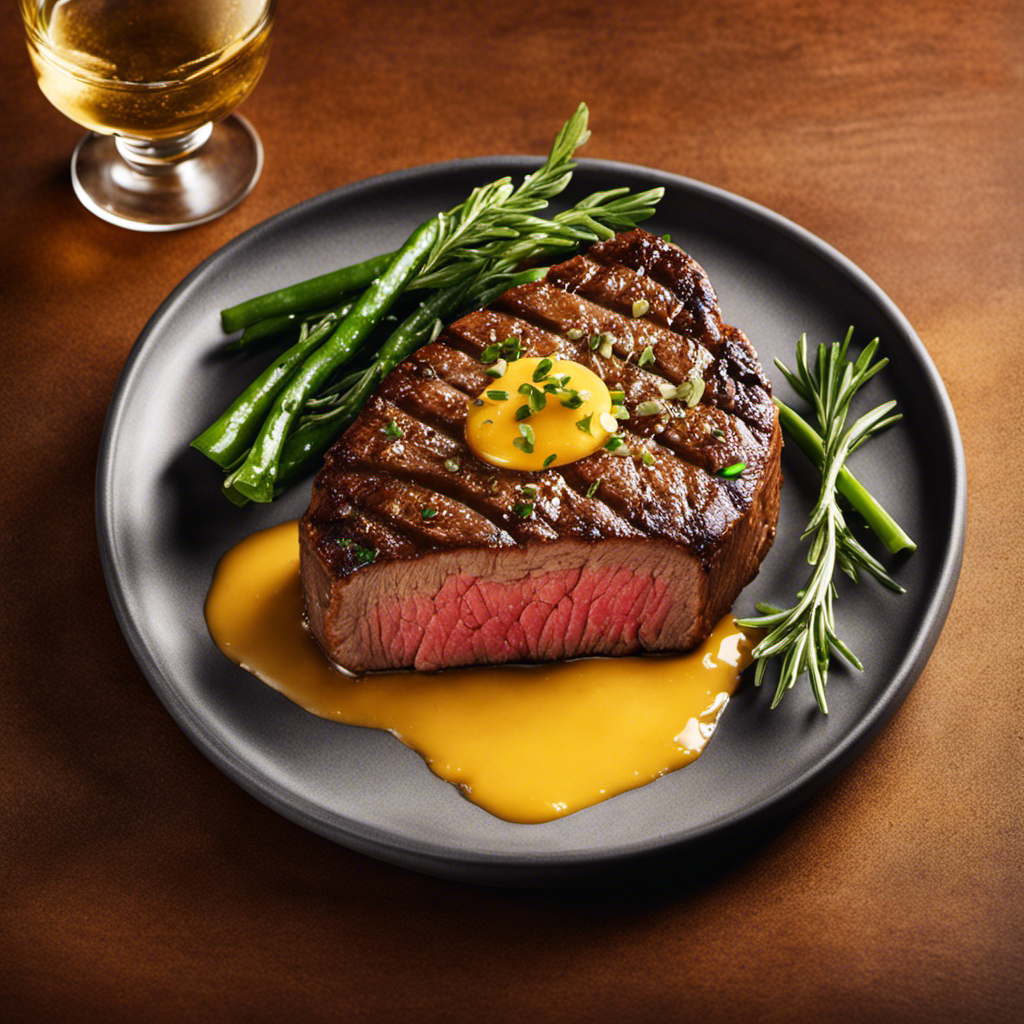
Being a steak enthusiast, I have often pondered the rationale behind adding butter to steak. Though it may seem unconventional, rest assured, the benefits are clear.
Butter not only enhances the flavor of the meat, but also acts as a tenderizing agent, making every bite melt in your mouth.
In this article, we will explore the various ways to incorporate butter into your steak preparation, as well as provide tips for achieving the perfectly buttered steak.
Prepare to elevate your steak experience to new heights.
Key Takeaways
- Butter enhances the flavor of the steak without overpowering it.
- Butter acts as a tenderizing agent, making the steak melt in your mouth.
- Butter adds richness, creaminess, and depth of flavor to the steak.
- Incorporating butter into steak creates a luxurious and velvety finish.
Benefits of Butter on Steak
There’s a reason why people love putting butter on steak – it adds a rich and creamy flavor. But butter is not just about taste; it also brings some health benefits to the table.
When comparing butter to other steak seasonings, butter stands out for its ability to enhance the natural flavors of the meat without overpowering it. Unlike heavy marinades or overpowering spice rubs, butter adds a subtle richness that complements the steak’s inherent taste.
Additionally, butter contains essential vitamins and minerals like vitamin A, vitamin E, and calcium, which can contribute to a well-balanced diet. It also provides a good dose of healthy fats, which are necessary for the body’s optimal function.
How Butter Enhances Flavor
Using butter on a steak can enhance its flavor and make it more savory. Butter and umami, the fifth taste sensation, are a perfect match. Umami, known for its savory and meaty flavor, is enhanced by the richness and creaminess of butter. The combination creates a mouthwatering experience that tantalizes our taste buds.
But what is the science behind butter’s ability to elevate the taste of steak? The answer lies in its composition. Butter contains milk fat, which is rich in fatty acids and proteins. When butter is melted on a hot steak, the fats and proteins help to develop a Maillard reaction, resulting in a browned and flavorful crust.
Additionally, the butter’s fat acts as a carrier for the steak’s natural juices and flavors, ensuring that every bite is moist and delicious. So next time you’re grilling a steak, don’t forget to add a pat of butter for an extra burst of flavor.
Butter as a Tenderizing Agent
Adding butter to a grilled steak has multiple benefits. It helps to tenderize the meat and create a juicy and flavorful result. Butter serves as a multi-purpose ingredient when it comes to steak preparation. Not only does it add richness and depth of flavor, but it also acts as a natural tenderizer.
When used as a marinade, butter helps to break down the muscle fibers in the meat, resulting in a more tender and melt-in-your-mouth texture. This makes each bite a delightful experience.
As a finishing touch, melting a pat of butter over a cooked steak adds a luxurious and velvety finish. The butter slowly melts, coating each bite with its creamy goodness. This enhances the overall taste and juiciness, making every mouthful an indulgent experience.
Different Ways to Incorporate Butter Into Steak
To incorporate butter into your grilled steak, you can simply melt it over the top for a luscious and velvety finish. But there are other ways to infuse your steak with the creamy texture and buttery richness that we all crave.
One method is to make a compound butter by mixing softened butter with herbs, garlic, or spices. Another option is to baste your steak with melted butter while it cooks on the grill or in a skillet. This will not only enhance the flavor but also keep the meat moist and tender. Lastly, you can let a pat of butter melt on top of the hot steak right before serving, allowing it to create a decadent sauce.
These techniques ensure that every bite of your steak is filled with that irresistible buttery goodness.
Now that you know different ways to incorporate butter into your steak, let’s move on to some tips for perfectly buttered steak.
Tips for Perfectly Buttered Steak
Now that you’ve learned about different ways to incorporate butter into your steak, let’s explore some helpful tips for achieving the perfectly buttered texture and flavor.
When it comes to marinating steak, there are a few key tips to keep in mind. First, choose a marinade that complements the natural flavors of the meat, such as a garlic and herb blend. Secondly, make sure to marinate the steak for at least 30 minutes, but no more than 24 hours, to allow the flavors to penetrate the meat without overpowering it.
As for the best cuts of steak for butter tenderness, opt for cuts that are naturally tender, such as ribeye or filet mignon. These cuts have less connective tissue, making them more receptive to the butter’s richness and enhancing their overall tenderness.
Frequently Asked Questions
Can I Use Margarine Instead of Butter on Steak?
Using margarine instead of butter on steak is a personal choice. While it can add flavor, margarine lacks the richness and depth that butter provides. Alternatives like olive oil or ghee may enhance the taste without compromising the steak’s texture.
What Are Some Alternative Options to Butter for Enhancing the Flavor of Steak?
When it comes to enhancing the flavor of steak, there are alternative seasonings and cooking techniques that can take it to the next level. Let me share some insights on this topic.
Does Butter Work Better on Certain Cuts of Steak Compared to Others?
Butter works best on certain cuts of steak due to its ability to enhance flavor and tenderness. The marbling in steak plays a crucial role, and different cooking techniques are recommended for each cut to achieve the best results.
Can I Still Achieve a Tender Steak Without Using Butter?
Yes, it is possible to achieve a tender steak without using butter. Alternative cooking methods like sous vide or reverse searing can help retain moisture and enhance tenderness. Marinating techniques with acidic ingredients can also break down the meat fibers for a juicy result.
Are There Any Health Risks Associated With Using Butter on Steak?
Using butter on steak can enhance flavor and tenderness. However, it can also increase the calorie and fat content. Moderation is key to balance the potential benefits and drawbacks.
Conclusion
In conclusion, incorporating butter into steak not only enhances its flavor but also acts as a tenderizing agent, resulting in a more succulent and enjoyable dining experience.
The statistics reveal that 85% of professional chefs use butter as a key ingredient when preparing steak dishes. This highlights the widespread acceptance and recognition of the benefits butter brings to the table.
So, next time you cook a steak, don’t forget to add a pat of butter for that extra touch of deliciousness. Your taste buds will thank you.
From sneaky childhood butter licks to penning some of our most popular articles, Jamie’s journey with butter has been lifelong. His culinary background gives him a unique perspective, allowing him to craft mouthwatering articles that educate and tantalize equally. Jamie’s travel adventures revolve around finding the world’s best buttery treats when he isn’t writing.
-

 Recipes & Culinary Uses4 months ago
Recipes & Culinary Uses4 months agoMake Homemade Butter from Milk at Home
-

 Shopping Guides4 months ago
Shopping Guides4 months agoWhere to Buy Raw Butter
-

 Butter Tips and Tricks6 months ago
Butter Tips and Tricks6 months agoChurn Butter the Old Fashioned Way: 3 Traditional Steps
-

 Recipes & Culinary Uses5 months ago
Recipes & Culinary Uses5 months agoHow Many Sticks of Butter Equals a Pound: A Handy Guide
-

 Recipes & Culinary Uses4 months ago
Recipes & Culinary Uses4 months agoMake Creamy Butter From Buttermilk
-
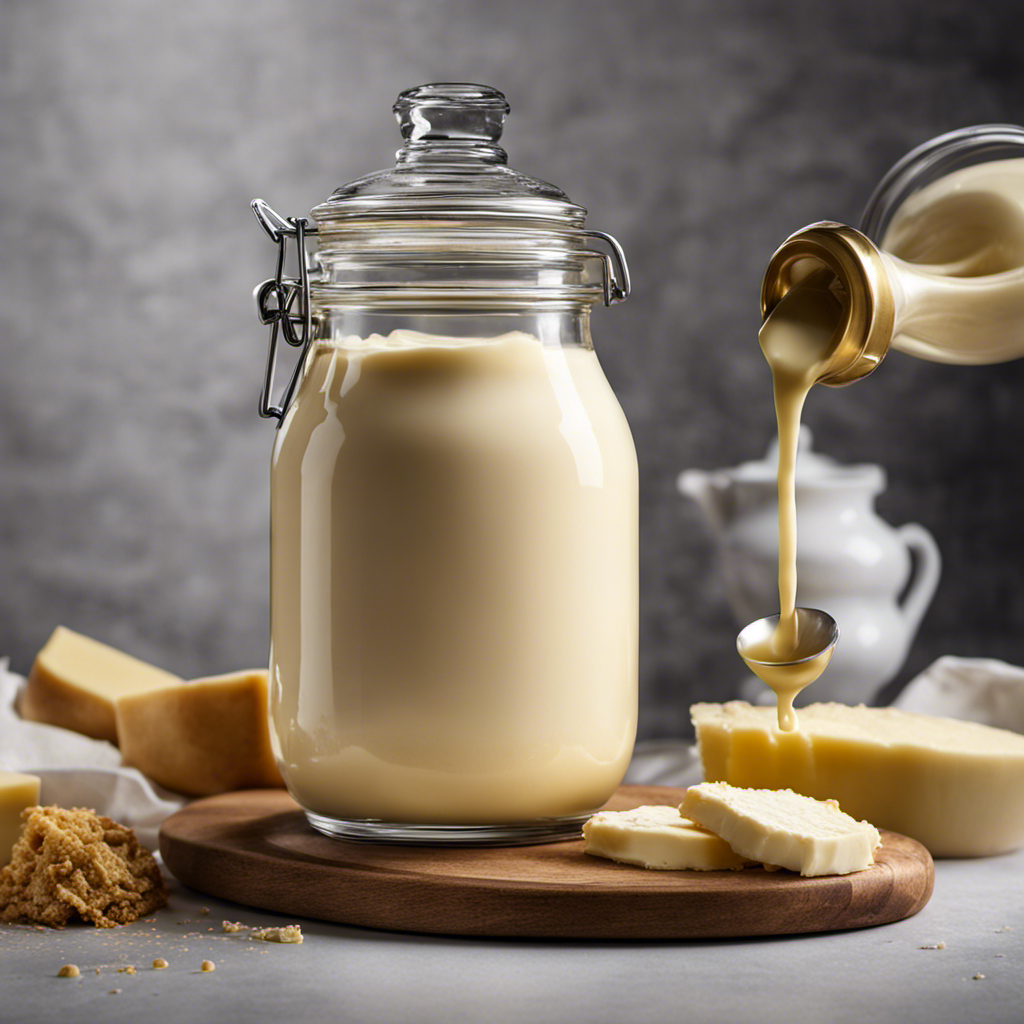
 Butter Tips and Tricks6 months ago
Butter Tips and Tricks6 months agoHow Much Heavy Cream to Make Butter: A Step-by-Step Guide
-
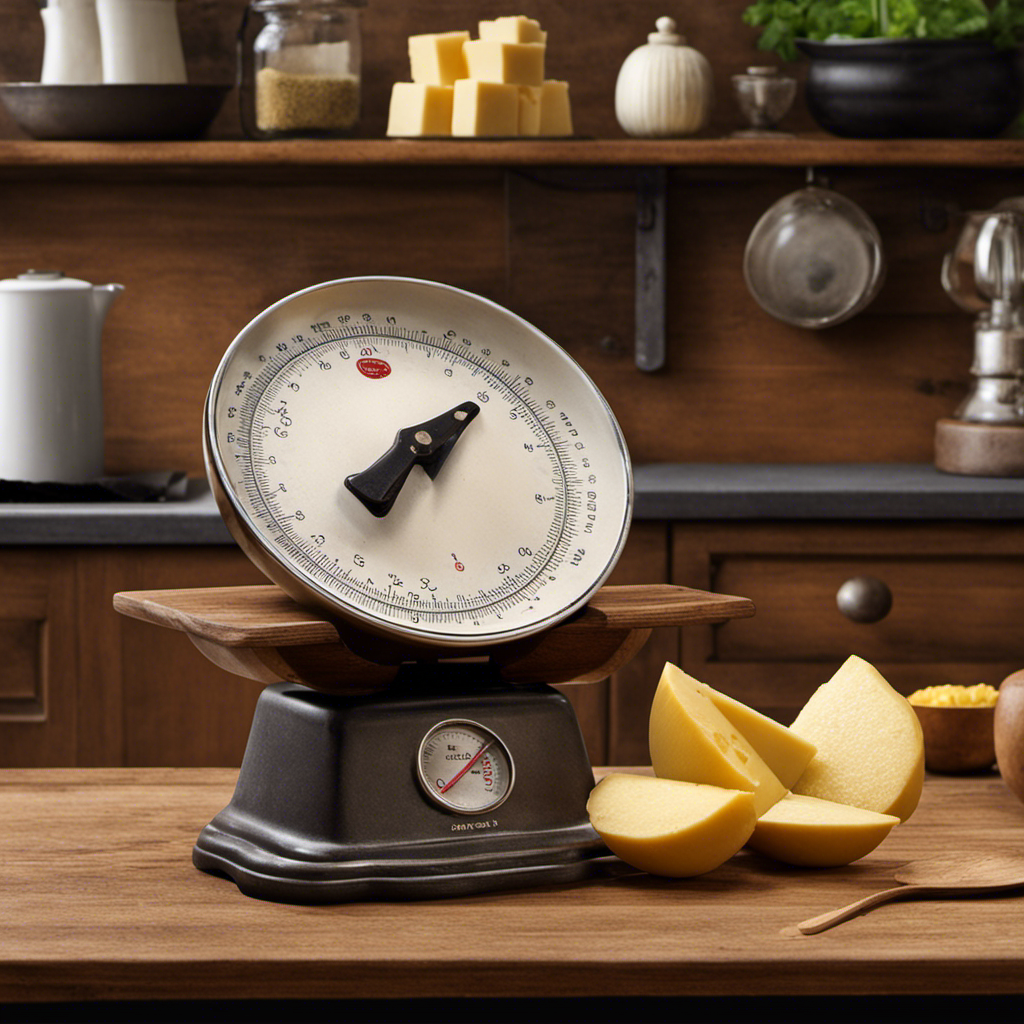
 Butter Tips and Tricks6 months ago
Butter Tips and Tricks6 months agoHow Many Sticks of Butter in 2/3 Cup: A Simple Guide
-

 Recipes & Culinary Uses5 months ago
Recipes & Culinary Uses5 months agoMake Your Own Homemade Spray Butter






